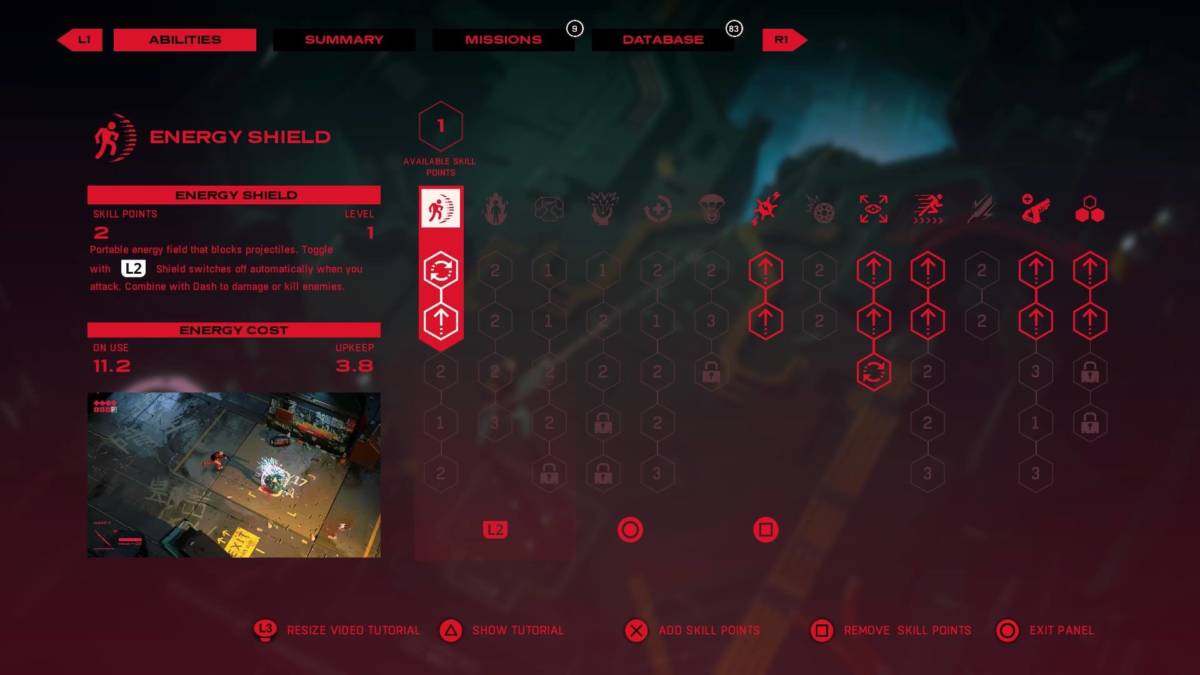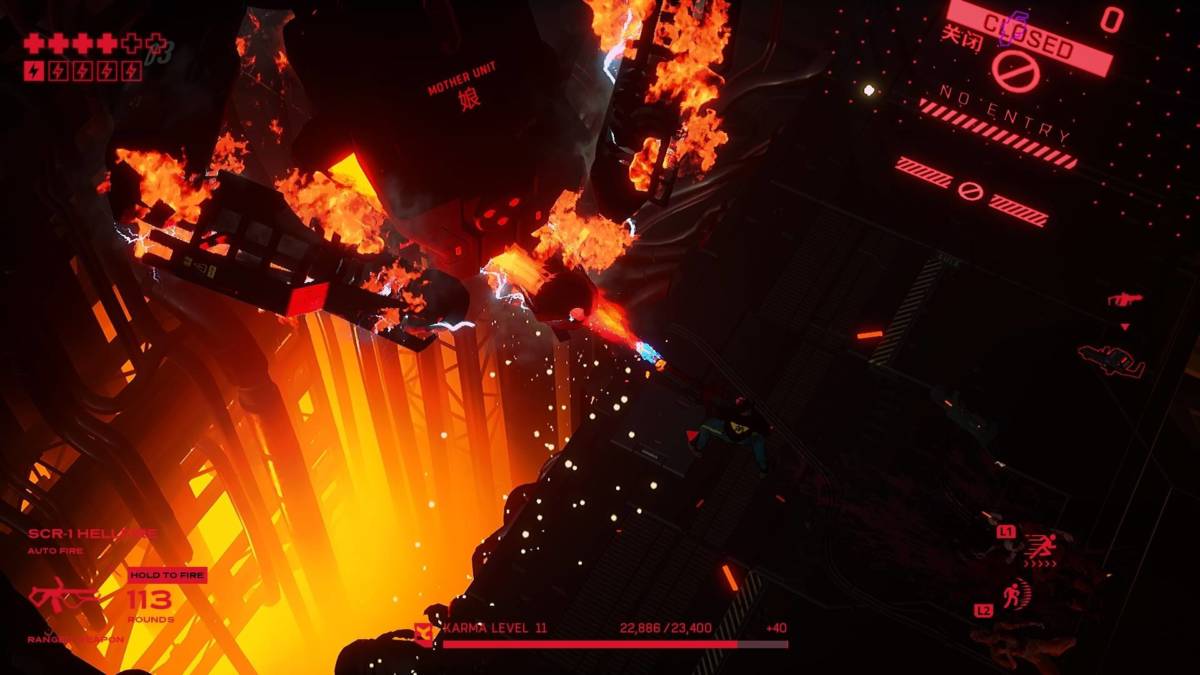RUINER is a game that you just can’t shake. It’s been over a week since I put my katana down, the last enemy slain and the final pulsating dark electro beat fading away, but I just can’t stop thinking about. Its sinisterly beautiful world and almost masochistic gameplay have made me want to step behind the LCD mask all over again without any hesitation.
If you haven’t played it yet, you should. In many ways, it’s like a Hotline Miami 3 we’ll never get to play, but to boil it down to such a simple comparison doesn’t really do it justice. There’s a lot going on beneath the surface of flickering neon lights and sketchy mega-corporations.
To find out more about RUINER, I chatted with Magdalena Tomkowicz, co-founder of Reikon Games and narrative director and Benedykt Szneider, creative director, to find out what went on behind the scenes, the team’s inspirations, and plans for the future.
How are you, and what was the last thing you ate? Arbitrary score out of 10?
Magdalena Tomkowicz: I’m very well, thank you. Although I still have a little of that post-production cold. It’s been holding me for over 2 weeks now. I just ate a fresh avocado stuffed with olives, capers and sardines with a lemon-vinaigrette sauce. It was delicious and nutritious.
It was very difficult to eat, though, and I got my hands all covered in the sauce so there’s no way I’m giving it more than 6/10.
Tell us about RUINER, how did it all start?
MT: It started during one of the then-regular game developers’ beer meetings. We were bitching about how it sucks to work for the big companies, of course. It was then that we had the a-ha moment: ok, so let’s do something ourselves finally. We already had a couple of ideas for a game but no experience in launching or running that kind of enterprise business-wise. The next day I set up a meeting with my friend who runs a creative collaboration agency. He gave us a couple pieces of a good advice and we rolled from there.
How long was it in development for? Did you face many bumps along the way?
MT: Including the pre-production, it all took about three years. The proper production started at the beginning of 2015. We were putting the furniture and PCs together between Christmas and the new Year’s Eve to start with the New Year. The bumps turned out to be waves that launched us even higher and bigger. We had to expand the team’s size considerably, so we’ve grown from 6 to 18. We had to learn to work with our ambitions and limitations and make the most out of them. There were moments of doubt, of course, but we also had to learn how to overcome them. All that was very educational not only in the context of game development.

RUINER has been receiving a pretty warm reception since release, especially for its style. What were some of your inspirations? I think I noticed a nod to Final Fantasy VII in the hub world, unless I am totally off-point?
Benedykt Szneider: Thanks, means a lot. We pursued directions that felt natural to us, since we all liked more or less similar stuff, ranging from badass don’t-give-a-fuck anime like Cyber City Oedo, to Carpenter movies and French sci-fi comic books. Probably more focused on the energy, the drive they gave us than anything else, like trying to grab the essence of what made those appeal to us more than some direct reference.
We wanted to make it interesting and worth players invested their time and at the same time not be too serious about it. It’s more about the vibe than some “predictable future” nonsense. Japanese games tend to have the greatest character pool, and FF is no exception. In that regard – especially looking at what comes out of Capcom – they were always a big influence on me.
A lot has been said about its difficulty. Was it always intended to challenge gamers, like you sat down one day and said, “let’s make a hard game”? I think it strikes a balance between difficult and gently nudging players towards the skill tree.
MT: It’s great to hear that from you as a player because it was exactly our idea. We wanted to make the game challenging, true, and very much so. But we also gave the players all the tools they would need to overcome the challenge. I’m talking about the abilities, of course.
To be honest, only recently I realized this amazing parallel between RUINER’s story and gameplay. Just as you’re hacked to kill the boss and it’s all you can think of, the same can be said about the way you approach gameplay: you get hacked with one setup and when things stop working out you blame it on the difficulty.

It can take some time to learn what it’s really about, and you might need help from someone else to unhack you so that instead of getting angry with the game you take a step back and ask yourself: why do I keep repeating that same thing over and over again? Maybe that setup I’m just so used to doesn’t work anymore? Maybe I’m just stuck and instead of getting angry I can readjust my priorities and see how it goes? When you open yourself to all the possibilities and don’t forget about them within your game, you’ll see that it’s not really that difficult and that the challenge is actually fun!
Production quality wise, RUINER is lovely to look at, but there isn’t much spoken dialogue, except for from Her. Is this something you wanted to include that you had to pull back on during production, or was it always the idea to have mainly visual storytelling?
MT: RUINER is first and foremost an action game. The idea was to keep it consistent. Meaning that the storytelling should match the pacing of the gameplay and not overwhelm the players with unnecessary amounts of text. We were aiming for the comic book experience where you can have a lot of action and, at the same time, a rich story told with very little text.
There was a turning point, though. Having received tons of positive feedback about the world and hearing that the players wanted to learn more about it, we added a couple of side missions and a database where you can read about all the important things – characters, objects, environments, etc. – you encounter in the game. They are entirely optional and don’t get in the way of the gameplay.
How do you approach making a game of this scale with a small team? There’s a lot of variety and scope here, certainly more than meets the eye.
MT: Yeah, so one thing was increasing the team’s size, which I mentioned before. Most of us have been involved in more than one thing along the whole production process, too. We also haven’t quite managed to avoid one of the game development’s curses, which is crunch.

Many team members haven’t had a vacation during the development. It sounds horrible and often felt terrible, too. It drained us and we only now have time to recover and regenerate. But you can’t really create anything extraordinary with an ordinary approach.
So most of us devoted the bigger part of our lives to making the game because we believed we’re making something great. And we were right :)
What are your plans for the previously mentioned updates for the game? Should we expect stuff by the end of year?
MT: Two DLCs are coming up. There will be speedrun/time attack mode and arena mode, new special attacks and finisher moves, and last but not least, online leaderboards. How does that sound?
Pretty damn good. The soundtrack is amazing. Did you have any music in mind before the project, or did it come together during production?
MT: Thanks! Music and sound in general was one of the four pillars of the game from the start. Only the way it eventually played out changed. At the beginning we thought we’d have local artists create an original soundtrack. We started contacting them very early in the production process, but while we had a perfect understanding and we shared the vision of what we wanted to create within the team, it proved extremely difficult to achieve that understanding with outsiders. So we let it go because it took too much time that we didn’t have.
Eventually we decided to do it the Hotline Miami way: look for cool music online and license it. With the exception of Susumu Hirasawa, it was how we did it. Because we didn’t find his music by accident. It took us a year to sign Hirasawa’s pieces. We couldn’t have done it without Devolver and Laced.
Finally, could we be seeing more of Puppy and Her in a possible sequel? Say yes.
MT: …we’ll see.
Some of the coverage you find on Cultured Vultures contains affiliate links, which provide us with small commissions based on purchases made from visiting our site. We cover gaming news, movie reviews, wrestling and much more.



